Understanding Drill Bit Sizes: A Comprehensive Guide

Drilling is a common household task that is used in a wide range of projects, from hanging shelves to building furniture. But have you ever been stuck trying to figure out what size drill bit to use? Understanding drill bit sizes can be a confusing task, as there are countless sizes and styles available. This comprehensive guide aims to demystify the world of drill bit sizes and help you select the right tool for your needs.
One of the most important factors to consider when choosing a drill bit is the diameter. Drill bit sizes are typically measured in fractions of an inch or in millimeters. The diameter of a drill bit determines the size of the hole it will create. For example, a 1/8-inch drill bit will create a 1/8-inch hole. It’s important to note that drill bit sizes can vary slightly between manufacturers, so it’s always a good idea to double-check the measurements.
In addition to diameter, drill bits also come in different lengths. The length of a drill bit refers to the distance from the tip to the shank, the part that attaches to the drill. Longer drill bits are useful for drilling through thicker materials, while shorter ones are better suited for shallower holes. It’s important to choose a drill bit with a length that matches the depth of the hole you need to create.
When working with different materials, such as wood, metal, or concrete, it’s important to choose a drill bit that is specifically designed for that material. Each material has different properties and requires a different type of drill bit to ensure efficient drilling and prevent damage to the material or the drill bit itself.
Understanding drill bit sizes is essential for any DIY enthusiast or professional. By knowing the diameter, length, and material compatibility of drill bits, you can confidently tackle your next drilling project with ease and precision.
Types of Drill Bits
Drill bits come in various shapes and sizes, each designed for a specific task or material. Here are some common types of drill bits:
1. Twist Drill Bits
Twist drill bits are the most common type of drill bits. They have a pointed tip and spiral flutes that help to remove material as the bit rotates. Twist drill bits are suitable for drilling into various materials such as wood, metal, and plastic.
2. Spade Bits
Spade bits, also known as paddle bits, have a flat spade-shaped blade with a pointed tip. These bits are primarily used for drilling large holes in wood. The flat blade design helps to create clean and precise holes.
3. Forstner Bits
Forstner bits are designed for drilling flat-bottomed holes with smooth sides. They have a cylindrical shape with a central point and two radial cutting edges. Forstner bits are commonly used for woodworking applications, such as installing hinges or creating mortises.
4. Hole Saw Bits
Hole saw bits consist of a circular blade attached to a mandrel. They are used for cutting large diameter holes in materials like wood, plastic, and metal. Hole saw bits are commonly used in construction and DIY projects.
5. Masonry Bits
Masonry bits, also known as concrete or hammer drill bits, are designed for drilling into hard materials like brick, concrete, and stone. These bits have a carbide or diamond tip that helps to penetrate tough surfaces.
6. Step Drill Bits
Step drill bits have a conical shape with multiple stepped diameter levels. They are commonly used for enlarging existing holes or creating holes with a specific diameter range. Step drill bits are suitable for drilling into various materials, including metal and plastic.
7. Countersink Bits
Countersink bits are designed to create a conical-shaped recess in a material’s surface, allowing screws to sit flush with the material. These bits often have a pilot drill bit at the center to guide the cutting action and prevent wandering.
8. Auger Bits
Auger bits have a screw-like shape with a threaded point that helps to pull the bit into the material while cutting. These bits are commonly used for drilling deep holes in wood and are often used in construction and woodworking applications.
9. Brad Point Bits
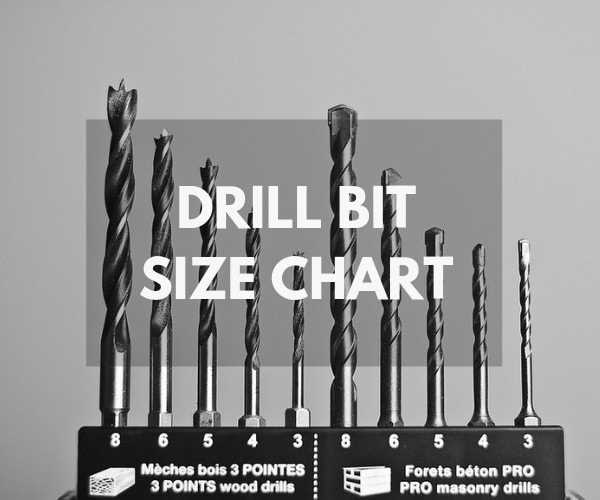
Brad point bits have a center point and two cutting edges that help to create clean and precise holes in wood. These bits are commonly used for woodworking applications, such as drilling holes for dowels or creating mortises.
10. Hex Shank Bits
Hex shank bits have a hexagonal-shaped shank that fits securely into a drill’s chuck, providing improved grip and preventing slipping. These bits are commonly used with impact drivers or drills with a quick-change chuck system.
These are just a few examples of the many types of drill bits available. Choosing the right drill bit for your task is essential to ensure optimal drilling performance and safety.
Standard Sizes
Drill bit sizes are commonly designated in fraction, letter, or number sizes. The most common standard sizes used in the industry are:
Fraction Sizes
- 1/64 inch – This is the smallest standard drill bit size available.
- 1/32 inch – Twice the size of a 1/64 inch drill bit.
- 1/16 inch – Twice the size of a 1/32 inch drill bit.
- 1/8 inch – Twice the size of a 1/16 inch drill bit.
- 1/4 inch – Twice the size of a 1/8 inch drill bit and the most commonly used standard size for general drilling purposes.
- 1/2 inch – Twice the size of a 1/4 inch drill bit and is typically used for larger drilling applications.
Letter Sizes
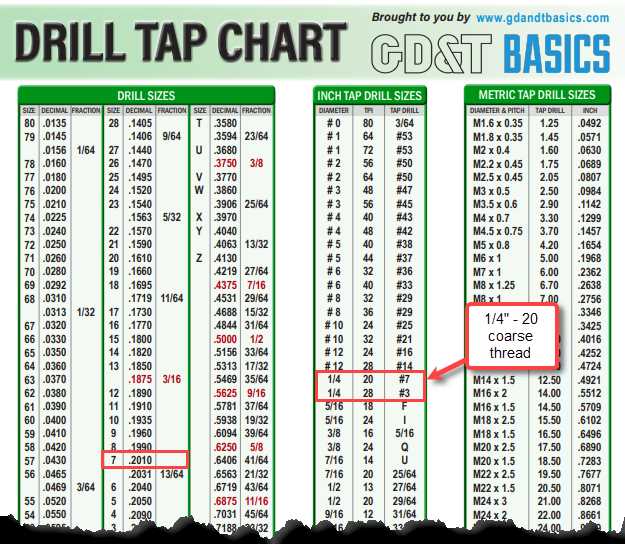
Letter sizes are designated by the letters of the alphabet, ranging from A to Z. Each letter represents a specific size of drill bit, with A being the smallest and Z being the largest. The most commonly used letter sizes in the industry include:
- A – Equivalent to a 1/8 inch drill bit.
- B – Equivalent to a 5/32 inch drill bit.
- C – Equivalent to a 9/64 inch drill bit.
- D – Equivalent to a 21/64 inch drill bit.
- E – Equivalent to a 11/32 inch drill bit.
- F – Equivalent to a 23/64 inch drill bit.
Number Sizes
Number sizes are designated by numerical values, typically ranging from 1 to 80. The higher the number, the smaller the drill bit size. The most commonly used number sizes in the industry include:
- #1 – Equivalent to a 0.228 inch drill bit.
- #2 – Equivalent to a 0.221 inch drill bit.
- #3 – Equivalent to a 0.213 inch drill bit.
- #4 – Equivalent to a 0.209 inch drill bit.
- #5 – Equivalent to a 0.205 inch drill bit.
- #6 – Equivalent to a 0.204 inch drill bit.
It is important to note that drill bit sizes can vary slightly between different manufacturers, so it is always recommended to double-check the size of a drill bit before purchasing or using it.
Fractional Inch Sizes
When working with drill bits, one of the most commonly used measurement systems is fractional inches. Fractional inch sizes are expressed in fractions of an inch and are commonly used in the United States and other countries that still rely on the imperial measurement system.
Drill bits come in a wide range of fractional inch sizes, and each size is designed for specific tasks. The larger the fraction, the larger the diameter of the drill bit. Common fractional inch sizes include 1/64″, 1/32″, 1/16″, 1/8″, 3/16″, 1/4″, 5/16″, 3/8″, 7/16″, 1/2″, 9/16″, and 5/8″.
Common Uses
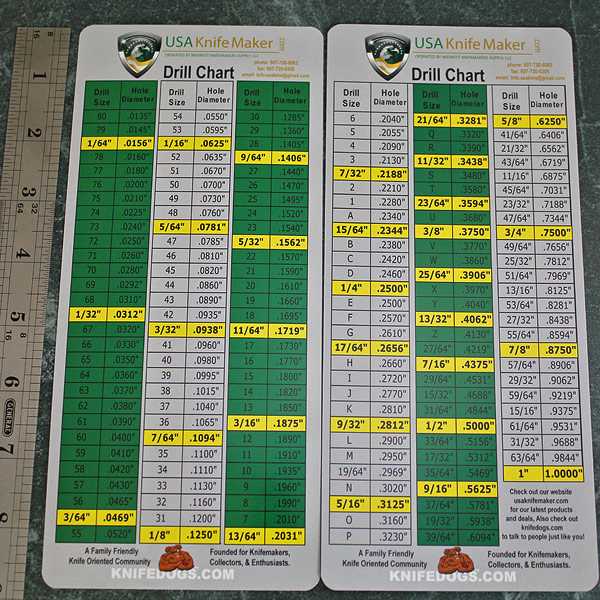
Fractional inch sizes are most commonly used for general woodworking and construction purposes. They are often used for tasks such as drilling pilot holes, creating clearance holes, and installing screws and other fasteners.
Due to their versatility, fractional inch sizes are also commonly used by DIY enthusiasts and hobbyists who work on a wide range of projects. From building furniture to installing shelves, fractional inch sizes are essential for a variety of woodworking and construction tasks.
Choosing the Right Size
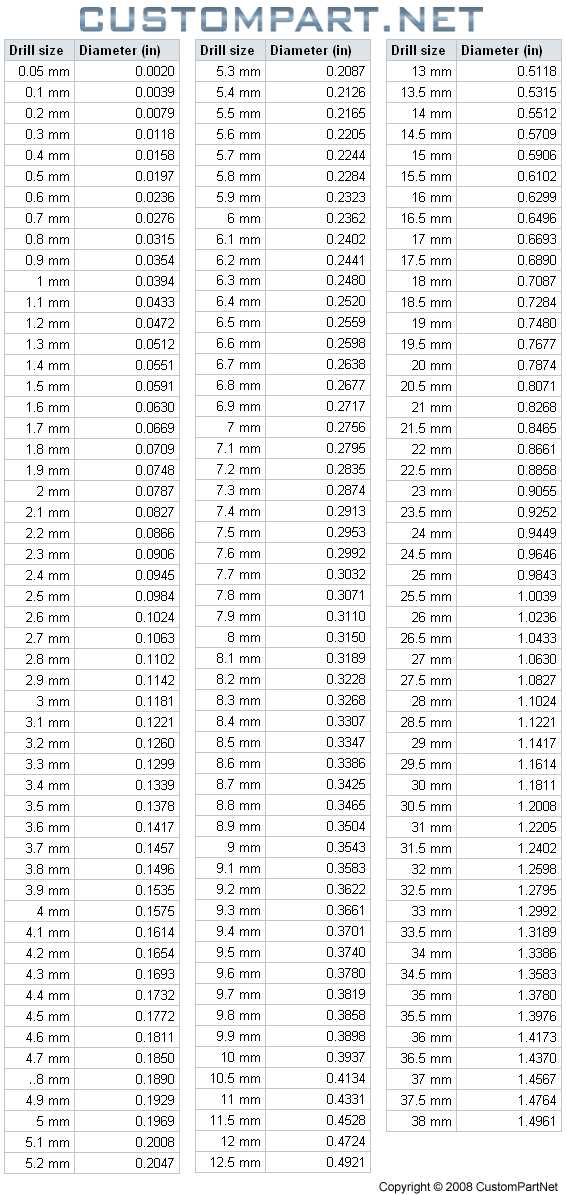
When choosing a drill bit size, it’s important to consider the specific requirements of your project. The right size will depend on factors such as the material you are drilling into, the type of hole you need to create, and the fastener you will be using.
To choose the right fractional inch size, it’s helpful to refer to a drill bit size chart or consult with an expert. These resources can provide guidance on which size is most suitable for your specific project. It’s also important to consider the type of drill bit you need – such as twist drill bits, spade drill bits, or brad point drill bits – as different types may have different size options.
Conclusion
Fractional inch sizes are a widely used measurement system in the world of drill bits. They provide a variety of size options to accommodate different types of projects and materials. By understanding fractional inch sizes and their common uses, you can choose the right drill bit size to ensure successful drilling and fastening in your woodworking and construction projects.
Metric Sizes
Metric drill bit sizes are commonly used in countries that have adopted the metric system. These sizes are expressed in millimeters (mm) and are generally rounded to the nearest whole number.
Below is a table listing some common metric drill bit sizes and their corresponding diameters:
| Diameter (mm) | Drill Bit Size |
|---|---|
| 1 | 1 mm drill bit |
| 2 | 2 mm drill bit |
| 3 | 3 mm drill bit |
| 4 | 4 mm drill bit |
| 5 | 5 mm drill bit |
| 6 | 6 mm drill bit |
| 8 | 8 mm drill bit |
| 10 | 10 mm drill bit |
| 12 | 12 mm drill bit |
| 14 | 14 mm drill bit |
| 16 | 16 mm drill bit |
| 18 | 18 mm drill bit |
| 20 | 20 mm drill bit |
It’s important to note that these sizes can vary slightly depending on the manufacturer and the purpose of the drill bit. Additionally, there are other metric sizes available, but the ones listed above are some of the most commonly used.
Decimal Inch Sizes
Drill bits are commonly measured in decimal inch sizes. This means that the size of the drill bit is given in inches as a decimal, rather than as a fraction or a gauge number. Decimal inch sizes provide a more precise and accurate measurement for drill bits.
The sizes of drill bits range from 0.001 inches to 3.0 inches or larger. The smallest drill bits, commonly used for delicate work such as jewelry making or electronics, have sizes like 0.03125 inches or 0.0625 inches. On the other hand, larger drill bits used for heavy-duty drilling can have sizes like 1.0 inches or 1.5 inches.
Decimal inch sizes are typically written with three digits after the decimal point. For example, a drill bit with a size of 0.250 inches would be written as “0.250” or “0.250 inches.” This level of precision allows for more accurate drilling and ensures that the hole will be the exact size needed for the intended purpose.
In addition to using decimal inch sizes, drill bits may also be labeled with their wire gauge equivalents. Wire gauge sizes are commonly used for drill bits that are specifically designed for drilling holes in metal. The wire gauge sizes range from 1 (smallest) to 80 (largest), with larger numbers indicating smaller drill bit sizes.
When selecting a drill bit for a specific project, it is important to consider the required hole size and the type of material being drilled. Drill bits come in a wide range of sizes and are designed for different materials, such as wood, metal, or concrete. Choosing the right drill bit size and type will ensure that the hole is drilled accurately and efficiently.
Advantages of Decimal Inch Sizes
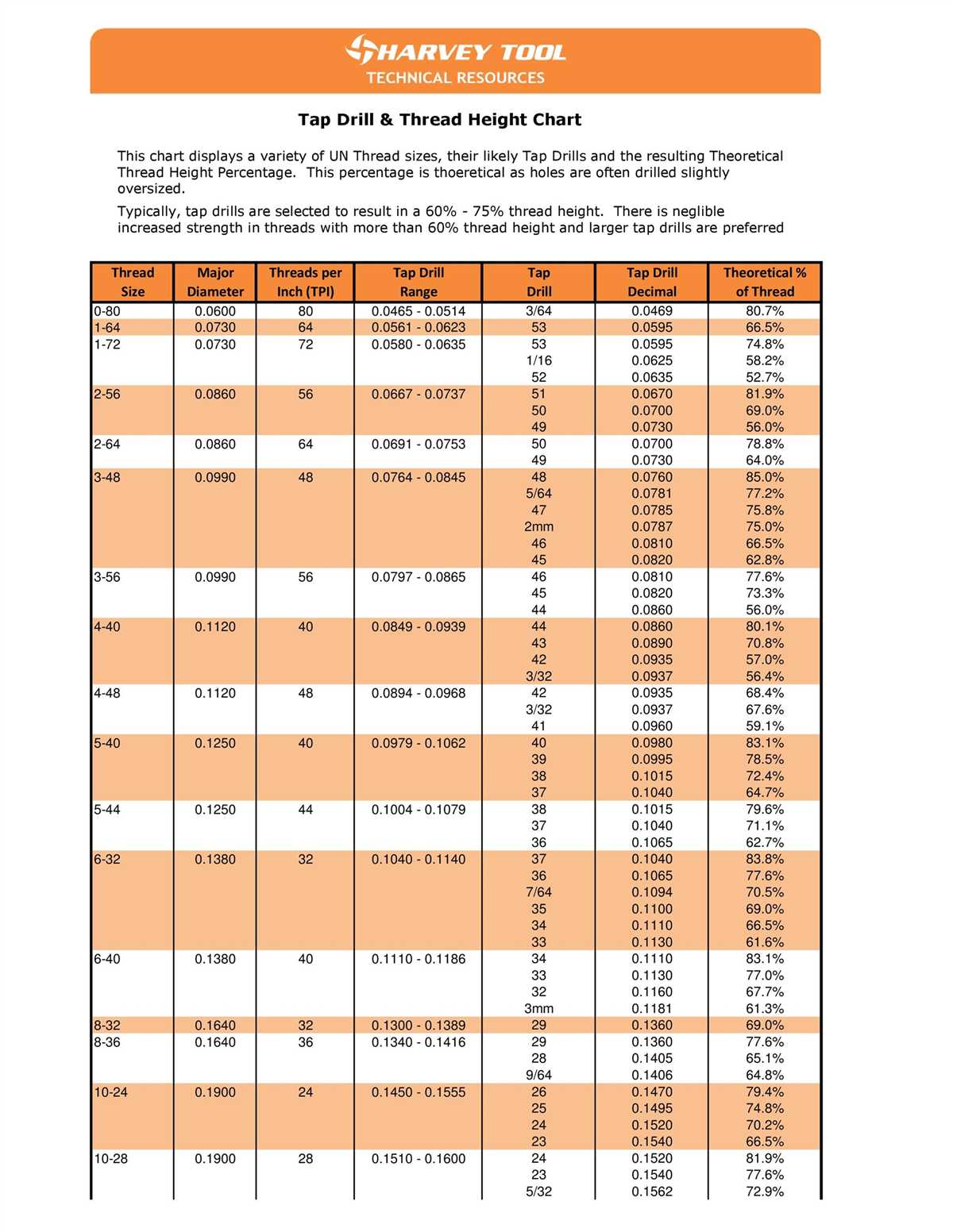
- Precision and accuracy
- More options for hole sizes
- Compatibility with other measurement systems, such as metric
- Wide range of available sizes
- Consistency in measurement across different drill bits
Disadvantages of Decimal Inch Sizes
- May require conversion for use with other measurement systems
- Smaller sizes may be harder to read or handle
- Less commonly used in certain industries or regions
Overall, decimal inch sizes provide a precise and versatile measurement system for drill bits. They offer a wide range of options for hole sizes and are compatible with other measurement systems. By understanding the decimal inch sizes of drill bits and considering the specific requirements of your project, you can ensure accurate and efficient drilling.
Converting Between Sizes
Converting between different drill bit sizes can be a bit confusing, especially if you are not familiar with the conversion ratios. However, with a clear understanding of the conversion formulas, you can easily convert between different drill bit sizes.
Converting from Fractional Inches to Decimal Inches
If you are working with fractional inch drill bits and need to convert them to decimal inches, you can use the following formula:
Decimal Inches = Numerator ÷ Denominator
For example, if you have a 1/2-inch drill bit, you can convert it to decimal inches by dividing the numerator (1) by the denominator (2), which equals 0.5 inches.
Converting from Fractional Inches to Millimeters
To convert fractional inch drill bit sizes to millimeters, you can use the following formula:
Millimeters = Decimal Inches × 25.4
For instance, if you have a 1/4-inch drill bit, you can convert it to millimeters by multiplying the decimal inches (0.25) by 25.4, resulting in 6.35 millimeters.
Converting from Decimal Inches to Fractional Inches
If you have a drill bit size in decimal inches and need to convert it to fractional inches, you can follow these steps:
- Convert the decimal to a fraction by finding a common denominator.
- Reduce the fraction to its simplest form (if possible).
- Use the fraction as the drill bit size.
For example, if you have a 0.375-inch drill bit, you can convert it to a fraction by following these steps:
- Convert 0.375 to a fraction by multiplying both the numerator and denominator by 1000, resulting in 375/1000.
- Reduce the fraction to its simplest form. In this case, it can be simplified to 3/8.
- The converted drill bit size is 3/8 inches.
Converting from Millimeters to Fractional Inches
To convert drill bit sizes from millimeters to fractional inches, you can use the following steps:
- Convert the millimeters to decimal inches by dividing the millimeters by 25.4.
- Apply the same steps as mentioned earlier to convert the decimal inches to fractional inches.
For instance, if you have a 6.35 millimeter drill bit, you can convert it to fractional inches by dividing 6.35 by 25.4, resulting in approximately 0.25 inches. Then, you can convert 0.25 inches to the nearest fraction using the steps mentioned earlier.
By understanding these conversion formulas, you can easily convert drill bit sizes between different measurement systems, allowing you to work with precision and accuracy in your projects.
Best Practices for Choosing the Right Size Bit
Choosing the right size bit is essential for successful drilling. Using the wrong size can result in various issues, such as damaged materials, inefficient drilling, and even safety hazards. Here are some best practices for selecting the correct bit size:
1. Understand the Material
Before choosing a drill bit size, it is crucial to consider the material you will be working with. Different materials require different bit sizes to achieve optimum results. For example, drilling through wood may require a smaller bit size compared to drilling through metal or concrete.
2. Refer to Drill Bit Size Charts
Drill bit size charts act as a helpful reference tool when you are unsure about the appropriate size for a particular project. These charts provide information on the recommended bit size for different materials and applications. Be sure to consult a reliable chart to guide your decision-making process.
3. Start with Smaller Bits
When in doubt, it is generally advisable to start with a smaller size bit and gradually increase if necessary. This approach allows for greater control and precision, especially when drilling into delicate or thin materials. Starting small also minimizes the risk of damaging the workpiece.
4. Consider the Desired Hole Size
Take into account the desired hole size when selecting a drill bit. While it may seem obvious, it is essential to choose a bit that matches the size of the hole you want to create. Additionally, consider whether you need a hole that is slightly larger than the bit size to accommodate for screws or anchors.
5. Measure the Shank Size
Aside from the drill bit diameter, it is also important to consider the shank size. The shank is the section of the bit that fits into the drill chuck. Ensure that the shank size matches the chuck size of your drill. Using a bit with the incorrect shank size can compromise both the drilling performance and safety.
6. Test on Scrap Material
Before drilling into your actual workpiece, it is recommended to test the chosen bit size on a scrap piece of the same material. This allows you to confirm that the bit size is appropriate and make any necessary adjustments before proceeding with the actual drilling.
7. Seek Professional Advice
If you are uncertain about the appropriate bit size for a specific application or lack experience in drilling, it is always a good idea to seek advice from professionals or experts in the field. They can provide guidance tailored to your specific needs and help you choose the right bit size for optimal results.
By following these best practices, you can ensure that you choose the right size bit for your drilling projects, resulting in efficient and safe drilling operations.
FAQ:
What is the purpose of drill bits?
Drill bits are tools that are used to create cylindrical holes in various materials such as wood, metal, and plastic.
How do drill bits differ in size?
Drill bits differ in size based on their diameter, which is measured in inches or millimeters. They come in a wide range of sizes to accommodate different hole sizes needed for various applications.
How can I determine the size of a drill bit?
To determine the size of a drill bit, you can use a drill bit gauge, which has a series of holes of different sizes that the bit can be inserted into. You can also use a caliper or a ruler to measure the diameter of the bit.
What are the common drill bit sizes?
Common drill bit sizes range from 1/16 inch to 1 inch, or from 0.2 mm to 25 mm. The most commonly used sizes are 1/4 inch, 3/8 inch, and 1/2 inch. However, there are many more sizes available to meet specific drilling needs.
What are the different types of drill bits?
There are several types of drill bits, including twist bits, spade bits, hole saws, countersink bits, and masonry bits. Each type is designed for specific materials and drilling applications.
Video:











